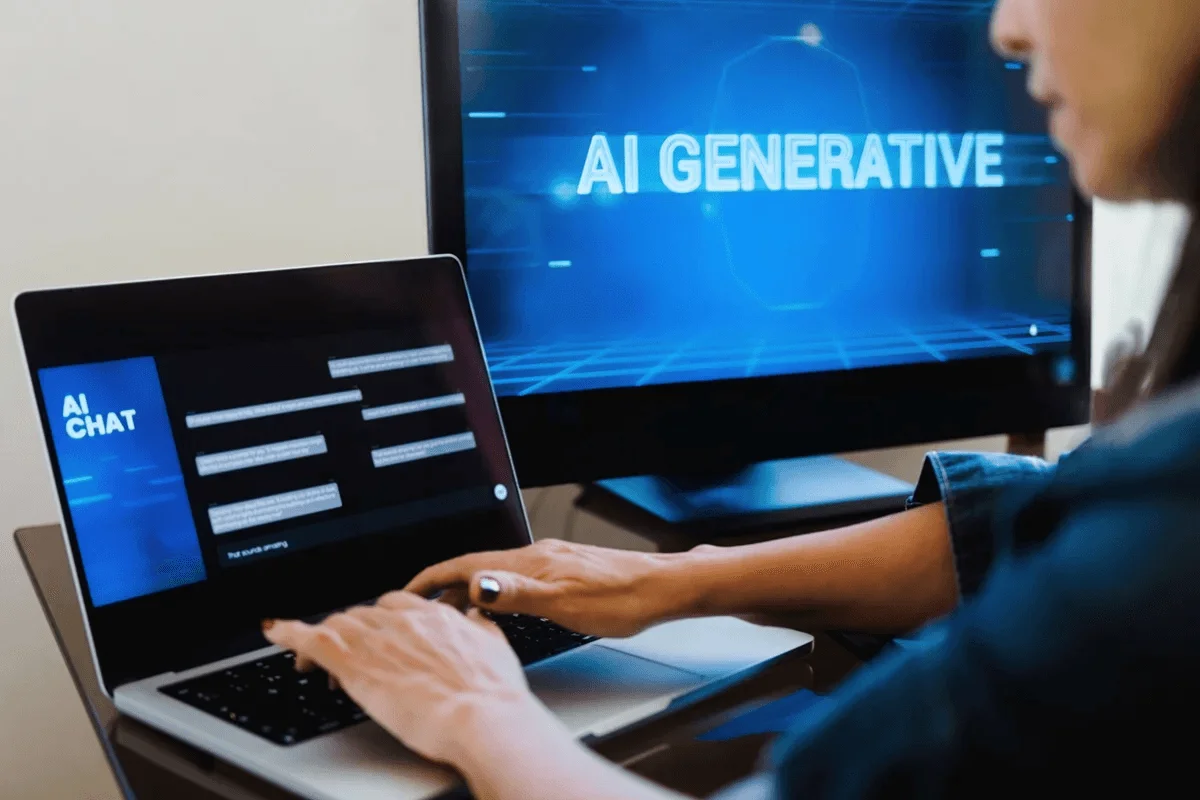Generative AI (GenAI) refers to a class of artificial intelligence systems capable of creating new content—such as text, images, audio, video, and code—based on patterns learned from existing data. A generative model is designed to create new data based on learned patterns. Unlike traditional AI models that are designed to classify or predict, generative AI models are built to generate content, mimicking the style, structure, or logic of the data they were trained on.
Text generation is a core function of generative AI, enabling the production of human-like text for applications such as summarization and question answering. A foundation model is a large-scale, pre-trained deep learning model that serves as the basis for generative AI applications.
These models, often powered by deep learning architectures like generative adversarial networks (GANs), variational autoencoders (VAEs), and large language models (LLMs), can produce highly realistic images and have ushered in a new era of human-AI collaboration, transforming creative, analytical, and operational workflows across industries. These deep learning models serve as foundation models for generative AI, providing a generalist base that can be fine-tuned for specific tasks.
These architectures are types of machine learning algorithms and neural networks that underpin generative AI capabilities. The structure and function of these models are inspired by the human brain, allowing them to identify patterns and generate content based on natural language understanding. Foundation models like GPT, BERT, and Gemini underpin many advanced AI tools, enabling content generation, understanding, and multitask functionalities across different data types such as text, images, and video.

How Does Generative AI Work?
Generative AI relies on machine learning algorithms that learn from massive datasets, with input data and unlabeled data as key components, and then generate similar—but-original outputs.
Generative AI works by processing input data, often including large amounts of unlabeled data, to learn patterns and relationships, and then generating new outputs based on this learned information.
The core methods include generating data that can take various forms:
1. Large Language Models (LLMs)
These are deep neural networks trained on text data for the primary function of text generation, enabling them to understand language, context, and intent.
These models are central to natural language processing tasks, powering applications such as summarization, translation, and question answering.
GPT (Generative Pretrained Transformer), BERT, and LLaMA are examples of transformer-based models. Historically, recurrent neural networks were used to analyze sequential data in natural language processing before being surpassed by transformer architectures.
2. Generative Adversarial Networks (GANs)
GANs (generative adversarial networks) use two neural networks: a generator and a discriminator. The generator creates content, including the ability to create realistic images and perform video generation, while the discriminator evaluates it. Through iterative feedback, the generator improves until it produces highly realistic outputs. GANs are also widely used to generate synthetic data for various applications.
3. Diffusion Models
Common in image generation (e.g., Stable Diffusion), these models gradually transform random noise into coherent visual content based on learned representations.
Diffusion models can also be used to create synthetic data for training and data augmentation.
4. Variational Autoencoders (VAEs)
VAEs compress data into a latent space and then decode it into new outputs. They’re widely used for generating high-dimensional data like images and audio.
Training and Fine-Tuning of Generative AI Models
The impressive capabilities of generative AI models stem from a rigorous process of training and fine-tuning. At the heart of this process is the use of vast and diverse training data, which allows these AI models to learn the intricate patterns, structures, and relationships within complex data sets.
For large language models and other generative models, training begins by exposing the model to enormous collections of text, images, or other data types. This training data can include everything from books and articles to user-generated content and web pages. By analyzing this information, the language models develop a deep understanding of natural language, context, and even subtle nuances, enabling them to generate content that feels authentic and relevant.
Once a generative AI model has been pre-trained on large-scale data, it often undergoes fine-tuning. Fine-tuning involves further training the model on more specific or curated datasets, allowing it to specialize in certain tasks, industries, or styles. For example, a large language model like GPT-3 may be fine-tuned to excel at legal writing, technical documentation, or customer support conversations. This process ensures that the generated content meets the unique requirements of different applications.
The combination of comprehensive training and targeted fine-tuning is what empowers generative AI models to produce high-quality, contextually accurate, and human-like outputs. As the field of generative artificial intelligence continues to evolve, the importance of robust training data and effective fine-tuning strategies will only grow, driving the next wave of innovation in AI-generated content and applications.
Examples of Generative AI Applications
Organizations increasingly use generative AI and generative AI solutions to enhance business processes and perform multiple tasks across industries. These technologies enable automation, improve efficiency, and support decision-making by integrating advanced AI capabilities into daily operations.
| Industry | Use Case |
|---|---|
| Marketing | Content writing, ad copy, email campaigns |
| Customer Support | AI chatbots, virtual assistants, conversational AI models, AI agents |
| Software Development | Code generation, bug fixes, documentation |
| Design & Media | Image generation, video synthesis, branding visuals |
| Healthcare | Drug discovery, medical imaging synthesis |
| Education | Personalized tutoring, content simplification |
| Finance | Report automation, risk modeling, fraud detection (with synthetic data) |
Generative AI apps and AI tools are increasingly integrated into workflows to automate and optimize multiple tasks across these industries.
Generative AI technologies are having a transformative impact, revolutionizing sectors such as finance, legal, manufacturing, and education.
Related Article:
AI Prompt Engineering: Your Key to More Effective AI-Human Interaction
Explore the significant benefits of AI prompt engineering in enhancing human interaction with a wide array of AI models. Read on to learn more!
Benefits of Generative AI
- Productivity Boost: Automates time-consuming tasks such as drafting, designing, or coding.
- Creativity Amplification: Assists professionals in exploring new creative directions faster.
- Cost Efficiency: Reduces the need for manual labor and streamlines production.
- Scalability: Enables personalized and scalable output generation for businesses.
- Accessibility: Lowers the barrier to entry for content creation and technical development.
Challenges and Ethical Concerns
Despite its promise, generative AI poses certain risks and limitations:
- Misinformation and Deepfakes: AI-generated content can be used maliciously.
- Bias and Fairness: Models may replicate biases present in training data.
- Intellectual Property: Questions around who owns AI-generated work remain unresolved.
- Data Privacy: Generative AI systems trained on sensitive or proprietary data may unintentionally replicate it.
Organizations must implement safeguards and responsible AI frameworks to ensure ethical deployment.
Generative AI vs. Traditional AI
| Aspect | Traditional AI | Generative AI |
|---|---|---|
| Function | Classify, predict, recommend | Generate new content |
| Input | Structured or labeled data | Vast datasets (text, images, etc.) |
| Output | Labels, scores, decisions | Text, images, videos, audio, code |
| Example Tools | Decision trees, regressions, SVMs | GPT-4, DALL·E, Stable Diffusion, Midjourney |
Is Generative AI the Future?
The rise of generative AI marks a significant leap forward in human-computer interaction. As models become more capable, intuitive, and multimodal (understanding both language and visual inputs), businesses will find new opportunities to innovate, automate, and engage customers.
Whether in automated journalism, synthetic training data, intelligent design assistants, or personalized education, generative AI is shaping the future of work, creativity, and communication.
GEO and Generative AI: Optimizing for the New AI Frontier
With AI-generated answers increasingly powering search and recommendation engines (e.g., Google’s AI Overviews and ChatGPT browsing), businesses must embrace Generative Engine Optimization (GEO). GEO focuses on optimizing content so it can be cited or summarized accurately by AI systems.
To stay visible:
- Structure content clearly (with H tags, bullets, tables).
- Demonstrate expertise, authority, and trustworthiness (EEAT).
- Use natural language and answer questions directly.
- Keep facts updated and sources credible.
A New Era of Intelligence and Innovation
Generative AI is not just a buzzword—it’s a paradigm shift. By empowering machines to think creatively and collaborate with humans, it opens the door to innovations we’ve only imagined.
From writing and design to scientific discovery and customer service, GenAI’s influence will only grow. As we navigate this new frontier, ethical implementation, responsible usage, and continual learning will define how successfully we harness its full potential.
Unlocking the Power of Generative AI
- Generative AI enables machines to produce original content that closely resembles human-created output.
- It is built on large-scale datasets and advanced machine learning models trained to understand context, structure, and semantics.
- Popular applications include content creation, customer support, design, synthetic media, code generation, and drug discovery.
- Tools like ChatGPT, DALL·E, Midjourney, and Claude are prime examples of generative AI models in use today.
Future-Proof Your Business with Trusted Outsourcing Solutions
Looking to future-proof your marketing strategy? We harness the capabilities of generative AI combined with expert human insight to deliver efficient, scalable, and customized digital marketing services. From content creation and SEO to social media management and automated campaigns, we empower brands to thrive in today’s AI-driven landscape.
Outsource your digital marketing to us and unlock smarter, faster, next-level growth. Get in touch today and let’s build your success.
Frequently Asked Questions
What are some common applications of generative AI?
Generative AI is used across multiple industries for tasks including text generation for content creation, image and video generation, code automation, synthetic data generation for training other AI models, drug discovery, and personalized customer interactions through chatbots and virtual assistants.
What is retrieval augmented generation (RAG) in generative AI?
Retrieval augmented generation is a technique that supplements generative AI models with external data sources to provide more accurate, up-to-date, and contextually relevant outputs beyond the original training data.
How is generative AI impacting the future of work?
Generative AI is transforming workflows by automating content creation, enhancing creativity, enabling personalized customer experiences, and supporting complex decision-making processes. It is expected to continue reshaping industries and creating new opportunities for innovation and efficiency.
Are there any popular generative AI tools available today?
Yes, some widely used generative AI tools include ChatGPT for text generation, DALL·E and Stable Diffusion for image creation, Midjourney for artistic visuals, and various AI-powered code generation assistants. These tools demonstrate the practical applications of generative AI technologies.








